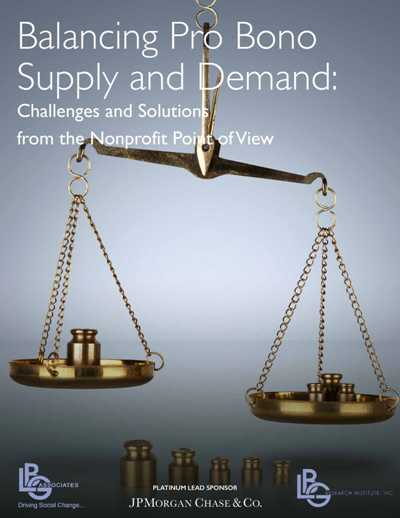Sarah Ford | November 17, 2015
How Companies Can Help Nonprofits Succeed Through Pro Bono
Guest Post By Linda B. Gornitsky | President, LBG Associates
The promise of pro bono is that skilled volunteers can lend their expertise to nonprofits thus reducing barriers to effectiveness. The problem is that accepting a pro bono volunteer is not necessarily easy for a nonprofit nor cost free. According to our survey of more than 1,400 nonprofits, the major challenge of engaging in a pro bono project is the time the project consumes for an already overworked staff.
Here at LBG Associates, we wanted to explore the challenges associated with pro bono and the solutions nonprofits have devised or imagine. The resulting report, “Balancing Pro Bono Supply and Demand: Challenges and Solutions from the Nonprofit Point of View,” was released at the Points of Light conference in October.
Top Challenges and How Corporations Can Help
The report identified the top challenges and a number of things corporations can do that would make pro bono projects go more smoothly. Here are just a few:
Nonprofit Challenge: Getting Started
Solution: Start Small. While it is tempting to go all out and want to provide strategic planning help, thinking small at first will help both sides get started as partners in pro bono engagements. Corporations can provide volunteers for small, discrete projects such as graphic design, web design, copywriting and others that will help the nonprofit start small and work its way, if needed, into more complex projects. Also, there is a greater likelihood of success if the project is discrete and time bound.
Nonprofit Challenge: Finding the Right Help
Solution: Give Them Choice. Frequently, the company chooses the volunteers and sends them in with no input from the nonprofits. The respondents were very clear that they want to have a choice with whom they work. Why not require that corporate volunteers provide a resumé and make themselves available to the nonprofit for an interview? The corporate pro bono manager can provide a list of potential volunteers and have the nonprofit make the final choice. This may not work in all cases but it is worth trying when there are multiple employees who can do the work and want to help.
Nonprofit Challenge: Finding the Time
Solution: Allow the Volunteer to Do Pro Bono During the Workday. Often the reason why projects derail is the availability of the volunteer. Too frequently the volunteer can only meet in the evenings and weekends, making the workday longer for stretched-thin nonprofit staff. As providers of volunteers, companies can make it easier on everyone if they support workday volunteering. If companies are going to have a pro bono program, they need to show their support by allowing their employees to attend meetings at the nonprofit during the day and to make time in their workday to complete pro bono work.
Nonprofit Challenge: Funding the Implementation
Solution: Include a Grant with the Pro Bono Project. Depending on the project, it may make sense to include an implementation grant to ensure that the work done on both sides shows a positive return. Nonprofits complain that volunteers made recommendations and then walked away. Pro bono volunteers can not only stick around to help with implementation but can also deliver the funds that will make the implementation possible.
Does Pro Bono Work?
Even with its challenges, the nonprofits reported that pro bono is well worth the time and trouble. The surveyed asked about success in a number of different ways. On all aspects, the respondents had good pro bono experiences. They said:
- 95% of nonprofits surveyed strongly agreed, agreed or somewhat agreed that their target issue was addressed
- 82% of projects undertaken by the respondents in the past three years were completed and the deliverable implemented
- 97% said the deliverable was at least somewhat useful; more than half said it was very useful or extremely useful
- 75% said the end product was a good return on their investment of time and resources
- Nearly 84% were at least somewhat satisfied with the overall pro bono experience
- 90% would engage in another pro bono project in the future
These results bode well for the growth of pro bono. Couple the current success rates with sensitivity to the challenges pro bono presents to nonprofits, and demand should start to meet supply. With the challenges in mind, corporations that have a pro bono program can have a heart-to-heart with the nonprofit partner about what will make these projects easier for them. Understanding the particular challenges of each partner and working with them to solve them is step one in building a long-term, successful pro bono partnership.
The report, “Balancing Pro Bono Supply and Demand: Challenges and Solutions from the Nonprofit Point of View,” is available for download free of charge at http://bit.ly/lbgprobono.
 Linda B. Gornitsky Ph.D. is president and founder of LBG Associates, a consulting firm that specializes in the development of strategic corporate citizenship and employee engagement programs, benchmarking, community attitude and evaluation studies, image-building/communications campaigns and efficient management practices. Linda can be reached at linda@lbg-associates.com or 203-325-3154. Visit www.lbg-associates.com to learn more about LBG Associate.
Linda B. Gornitsky Ph.D. is president and founder of LBG Associates, a consulting firm that specializes in the development of strategic corporate citizenship and employee engagement programs, benchmarking, community attitude and evaluation studies, image-building/communications campaigns and efficient management practices. Linda can be reached at linda@lbg-associates.com or 203-325-3154. Visit www.lbg-associates.com to learn more about LBG Associate.

Get Resources and Insights Straight To Your Inbox
Explore More Articles
Open Position: Customer Service Coordinator (Remote-Part Time)
Position Title: Customer Service Coordinator (Remote – Part Time) Department: Charitable Funds Management Solutions We are a non-profit charitable organization looking for skilled individuals who…
Read ArticleGet Resources and Insights Straight To Your Inbox
Receive our monthly/bi-monthly newsletter filled with information about causes, nonprofit impact, and topics important for corporate social responsibility and employee engagement professionals, including disaster response, workplace giving, matching gifts, employee assistance funds, volunteering, scholarship award program management, grantmaking, and other philanthropic initiatives.





